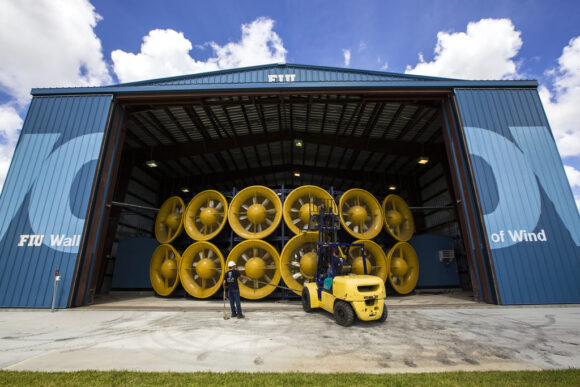In the not-too-distant future, researchers should be able to see exactly which materials and construction techniques hold up best against the worst that Mother Nature has to offer: 200-mph winds, storm surges and the pounding of waves – all at the same time – thanks in part to a $12.8 million grant from the National Science Foundation.
The idea is to design, test and then ultimately build a state-of-the-art facility that’s unlike any other in the world, perhaps as large as a football stadium, explained Professor Richard Olson, director of the Extreme Events Institute and hurricane research at Florida International University in Miami.
FIU already is home to the famed Wall of Wind facility, but that system can generate winds only as high as 157 mph, with no water or wave-testing capability. And the Insurance Institute for Business & Home Safety in South Carolina, funded by property insurers, tests building systems and materials for wind, hail and rain resistance.

The proposed storm-testing facility would be the first to combine all the forces of a catastrophic and unprecedented Category 6 hurricane, like one that experts fear will hit Florida and other coastal areas in coming years.
The system “would be capable of putting a full-sized, two-story house at the end of a water table, and you would have all three elements – 200 mph winds, a storm surge and wave action,” Olson said.
The initial grant from NSF would fund only the research needed to model and design the structure. Although the grant application suggests the research could take four years, “we should know a lot after two or three years,” Olson said.
Further grant funding is expected once the design is finalized. Once the testing center is operational, the information gleaned from it could prove invaluable to insurers, building code designers and to local governments around the world.
Nine major U.S. universities are collaborating on the program. These include Colorado State University, the Georgia Institute of Technology, Oregon State University, Stanford University, the University of Florida, the University of Illinois at Urbana-Champaign, the University of Notre Dame and Wayne State University. Maryland-based Aerolab LLC, a maker of wind tunnels, also is participating.
The program will begin with a small-scale prototype facility at FIU. The larger structure could be built at FIU or another institution, either by retrofitting an existing site or building a new one, the grant award notes. Joy Pauschke, of the National Science Foundation’s civil, mechanical and manufacturing innovation program, is the program manager. Arindam Chowdhury, civil and environmental engineering professor at FIU, is the principal investigator. Chowdhury and FIU also were recently awarded a separate, $5.7 million NSF grant to lead further wind research using the 12-fan, 8,400 horsepower Wall of Wind system at the university.

While researchers around the country have largely focused on the effects of hurricane-strength winds, less investigation has been done into how structures can better withstand waves and flooding, Olson said. The proposed facility that will take that holistic approach has been dubbed NICHE, short for National Full-scale Testing Infrastructure for Community Hardening in Extreme Wind, Surge, and Wave Events.
Now is the time to invest in what could be the world’s largest storm-effects testing site, researchers said.
“The risk to the nation’s society and assets, especially to civil infrastructure, e.g., residential homes, buildings, bridges, and critical utility systems, is now compounded by increasing hazard exposure and sea level rise due to anthropogenic warming,” the NSF grant award abstract explains. “The envisioned NICHE responds to a pressing national imperative to promote more resilient communities by reducing losses, population displacement, and outmigration due to climate-driven hazards, enabling communities to thrive sustainably and equitably to improve quality of life.”
The wind-and-wave research, like many aspects affecting Florida’s building codes and insurance market, began with Hurricane Andrew, the devastating storm that hit South Florida in 1992.
“It goes back to Andrew,” Olson said. “FIU made hurricane research part of its identity. And that gave us a platform to pursue the next facility.”
Andrew produced winds of 165 mph, according to news reports. But in the last few years, a few hurricanes have been stronger.
“Hurricane Dorian really got my freaking attention,” Olson said, referring to the 2019 storm that scraped the Bahamas with 185-mph winds. “It was just two days away and could have come to Miami.”
Top photo: Fan system at FIU’s Wall of Wind testing facility. (Courtesy of FIU)
Topics Windstorm Training Development
Was this article valuable?
Here are more articles you may enjoy.



 Hartford Q1 Income Up 41% on Commercial Lines as Auto Results Improve
Hartford Q1 Income Up 41% on Commercial Lines as Auto Results Improve  Ban on Worker Noncompetes Faces Uphill Legal Battle
Ban on Worker Noncompetes Faces Uphill Legal Battle  Marsh McLennan Agency to Buy Fisher Brown Bottrell for About $316M
Marsh McLennan Agency to Buy Fisher Brown Bottrell for About $316M  Two Montgomery Workers Charged with Insurance Fraud in Alabama
Two Montgomery Workers Charged with Insurance Fraud in Alabama 


